![]()
Androgenesis
- Androgenesis is the process in which embryo develop without genetic contribution from Oocytes.
- In Androgenesis, the male gametophyte (Microspore or immature pollen) produces haploid plants.
- The basic Principal is to stop the development of pollen cell into a gamete (Sex cell) and force it to develop into a haploid plant.
- There are two approaches in androgenesis, anther culture and pollen (Microspore) culture.
- Young plants grown under optimal condition of light temperature and humidity are suitable for androgenesis.
Anther Culture
- The selected flower buds of young plants are surface-sterilized and anthers removed along with their filaments.
- The anthers are excised under aseptic conditions, and crushed in 1% acetocarmine to test the stage of pollen development.
- If they are at the correct stage, each anther is gently separated (from the filament) and the intact anthers are inoculated on a nutrient medium.
- Injured anthers should not be used in cultures as they result in callusing of anther wall tissue.
- The anther cultures are maintained in alternating periods of light (12-18 hr.) and darkness (6-12 hrs.) at 28°C.
- As the anthers proliferate, they produce callus which later forms an embryo and then a haploid plant .

Pollen (Microspore) Culture:
- Haploid plants can be produced from immature pollen or microspores (male gametophytic cells).
- The pollen can be extracted by pressing and squeezing the anthers with a glass rod against the sides of a beaker.
- The pollen suspension is filtered to remove anther tissue debris.
- Viable and large pollen (smaller pollen do not regenerate) are concentrated by filtration, washed and collected.
- These pollen are cultured on a solid or liquid medium.
- The callus/embryo formed is transferred to a suitable medium to finally produce a haploid plant , and then a diploid plant (on colchicine treatment).
Comparison between anther and pollen cultures:
- Anther culture is easy, quick and practicable.
- Anther walls act as conditioning factors and promote culture growth.
- Thus, anther cultures are reasonably efficient for haploid production.
- The major limitation is that the plants not only originate from pollen but also from other parts of anther.
- This results in the population of plants at different ploidy levels (diploids, aneuploids).
- The disadvantages associated with anther culture can be overcome by pollen culture.
Many workers prefer pollen culture, even though the degree of success is low, as it offers the following advantages:
i. Undesirable effects of anther wall and associated tissues can be avoided.
ii. Androgenesis, starting from a single cell, can be better regulated.
iii. Isolated microspores (pollen) are ideal for various genetic manipulations (transformation, mutagenesis).
iv. The yield of haploid plants is relatively higher.
Development of Androgenic Haploids:
The process of in vitro androgenesis for the ultimate production of haploid plants is depicted in Fig.
The cultured microspores mainly follow four distinct pathways during the initial stages of in vitro androgenesis.
Pathway I:
The uninucleate microspore undergoes equal division to form two daughter cells of equal size e.g. Datura innoxia.
Pathway II:
In certain plants, the microspore divides unequally to give bigger vegetative cell and a smaller generative cell. It is the vegetative cell that undergoes further divisions to form callus or embryo. The generative cell, on the other hand, degenerates after one or two divisions—e.g., Nicotiana tabacum, Capsicum annuum.
Pathway III:
In this case, the microspore undergoes unequal division. The embryos are formed from the generative cell while the vegetative cell does not divide at all or undergoes limited number of divisions e.g. Hyocyamus niger.
Pathway IV:
The microspore divides unequally as in pathways I and II. However, in this case, both vegetative and generative cells can further divide and contribute to the development of haploid plant e.g. Datura metel, Atropa belladonna.
At the initial stages, the microspore may follow any one of the four pathways described above. As the cells divide, the pollen grain becomes multicellular and burst open. This multicellular mass may form a callus which later differentiates into a plant (through callus phase). Alternately, the multicellular mass may produce the plant through direct embryogenesis (Fig. ).
Factors Affecting Androgenesis:
A good knowledge of the various factors that influence androgenesis will help to improve the production of androgenic haploids. Some of these factors are briefly described.
Genotype of donar plants:
The success of anther or pollen culture largely depends on the genotype of the donor plant. It is therefore important to select only highly responsive genotypes. Some workers choose a breeding approach for improvement of genotype before they are used in androgenesis.
Stage of microspore or pollen:
The selection of anthers at an ideal stage of microspore development is very critical for haploid production. In general, microspores ranging from tetrad to bi-nucleate stages are more responsive. Anthers at a very young stage (with microspore mother cells or tetrads) and late stage (with bi-nucleate microspores) are usually not suitable for androgenesis. However, for maximum production of androgenic haploids, the suitable stage of microspore development is dependent on the plant species, and has to be carefully selected.
Physiological status of a donar plant:
The plants grown under best natural environmental conditions (light, temperature, nutrition, CO2 etc.) with good anthers and healthy microspores are most suitable as donor plants. Flowers obtained from young plants, at the beginning of the flowering season are highly responsive. The use of pesticides should be avoided at least 3-4 weeks preceding sampling.
Pretreatment of anthers:
The basic principle of native androgenesis is to stop the conversion of pollen cell into a gamete, and force its development into a plant. This is in fact an abnormal pathway induced to achieve in vitro androgenesis. Appropriate treatment of anthers is required for good success of haploid production.
Treatment methods are variable and largely depend on the donor plant species:
1. Chemical treatment:
Certain chemicals are known to induce parthenogenesis e.g. 2-chloroethylphosphonic acid (ethrel). When plants are treated with ethreal, multinucleated pollens are produced. These pollens when cultured may form embryos.
2. Temperature influence:
In general, when the buds are treated with cold temperatures (3-6°C) for about 3 days, induction occurs to yield pollen embryos in some plants e.g. Datura, Nicotiana. Further, induction of androgenesis is better if anthers are stored at low temperature, prior to culture e.g. maize, rye. There are also reports that pretreatment of anthers of certain plants at higher temperatures (35°C) stimulates androgenesis e.g. some species of Brassica and Capsicum.
Effect of light:
In general, the production of haploids is better in light. There are however, certain plants which can grow well in both light and dark. Isolated pollen (not the anther) appears to be sensitive to light. Thus, low intensity of light promotes development of embryos in pollen cultures e.g. tobacco.
Effect of culture medium:
The success of another culture and androgenesis is also dependent on the composition of the medium. There is, however, no single medium suitable for anther cultures of all plant species. The commonly used media for anther cultures are MS, White’s, Nitsch and Nitsch, N6 and B5. These media in fact are the same as used in plant cell and tissue cultures. In recent years, some workers have developed specially designed media for anther cultures of cereals.
Sucrose, nitrate, ammonium salts, amino acids and minerals are essential for androgenesis. In some species, growth regulators — auxin and/or cytokinin are required for optimal growth. In certain plant species, addition of glutathione and ascorbic acid promotes androgenesis. When the anther culture medium is supplemented with activated charcoal, enhanced androgenesis is observed. It is believed that the activated charcoal removes the inhibitors from the medium and facilitates haploid formation.













